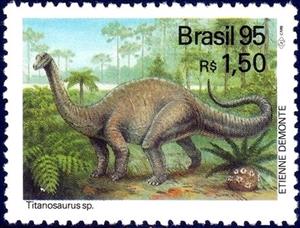Stamp: Titanosaurus (Brazil 1995)
Titanosaurus (Brazil 1995)
23 July (Brazil ) within release Congress the National Society for Paleontology goes into circulation Stamp Titanosaurus face value 1.50 Brazilian real
| Stamp Titanosaurus in catalogues | |
|---|---|
| RHM: | RHM:BR C-1952 |
Stamp is square format.
Also in the issue Congress the National Society for Paleontology:
- Stamp - Angaturama limia face value 0.15;
- Stamp - Titanosaurus face value 1.50;
|
Data entry completed
50%
|
|
|---|---|
| Stamp Titanosaurus in digits | |
| Country: | Brazil |
| Date: | 1995-07-23 |
| Perforation: | 11½ x 12 |
| Emission: | Commemorative |
| Format: | Stamp |
| Face Value: | 1.50 Brazilian real |
Stamp Titanosaurus it reflects the thematic directions:
Dinosaurs are a diverse group of reptiles of the clade Dinosauria. They first appeared during the Triassic period, between 243 and 233.23 million years ago (mya), although the exact origin and timing of the evolution of dinosaurs is a subject of active research. They became the dominant terrestrial vertebrates after the Triassic–Jurassic extinction event 201.3 mya and their dominance continued throughout the Jurassic and Cretaceous periods. The fossil record shows that birds are feathered dinosaurs, having evolved from earlier theropods during the Late Jurassic epoch, and are the only dinosaur lineage known to have survived the Cretaceous–Paleogene extinction event approximately 66 mya. Dinosaurs can therefore be divided into avian dinosaurs—birds—and the extinct non-avian dinosaurs, which are all dinosaurs other than birds.
Animals are multicellular, eukaryotic organisms of the kingdom Animalia (also called Metazoa). All animals are motile, meaning they can move spontaneously and independently, at some point in their lives. Their body plan eventually becomes fixed as they develop, although some undergo a process of metamorphosis later on in their lives. All animals are heterotrophs: they must ingest other organisms or their products for sustenance.


